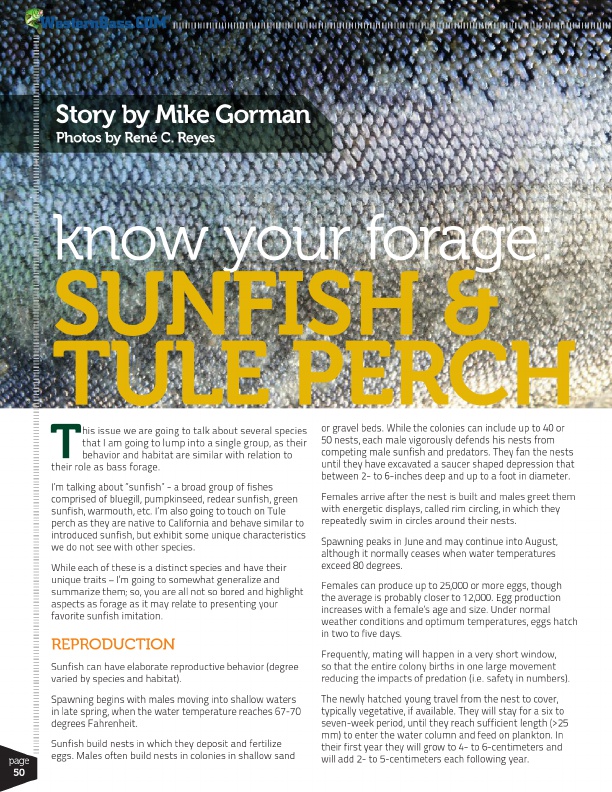
®
Winter 2018
Story by Mike Gorman
Photos by René C. Reyes
know your forage:
TSUUNLEFIPSEHR&CH
T
his issue we are going to talk about several species
that I am going to lump into a single group, as their
behavior and habitat are similar with relation to their role as bass forage.
I’m talking about “sunfish” - a broad group of fishes comprised of bluegill, pumpkinseed, redear sunfish, green sunfish, warmouth, etc. I’m also going to touch on Tule perch as they are native to California and behave similar to introduced sunfish, but exhibit some unique characteristics we do not see with other species.
While each of these is a distinct species and have their unique traits – I’m going to somewhat generalize and summarize them; so, you are all not so bored and highlight aspects as forage as it may relate to presenting your favorite sunfish imitation.
REPRODUCTION
Sunfish can have elaborate reproductive behavior (degree varied by species and habitat).
or gravel beds. While the colonies can include up to 40 or 50 nests, each male vigorously defends his nests from competing male sunfish and predators. They fan the nests until they have excavated a saucer½shaped depression that between 2- to 6-inches deep and up to a foot in diameter.
Females arrive after the nest is built and males greet them with energetic displays, called rim circling, in which they repeatedly swim in circles around their nests.
Spawning peaks in June and may continue into August, although it normally ceases when water temperatures exceed 80 degrees.
Females can produce up to 25,000 or more eggs, though the average is probably closer to 12,000. Egg production increases with a female’s age and size. Under normal weather conditions and optimum temperatures, eggs hatch in two to five days.
Frequently, mating will happen in a very short window, so that the entire colony births in one large movement reducing the impacts of predation (i.e. safety in numbers).
page 50
Spawning begins with males moving into shallow waters in late spring, when the water temperature reaches 67-70 degrees Fahrenheit.
Sunfish build nests in which they deposit and fertilize eggs. Males often build nests in colonies in shallow sand
The newly hatched young travel from the nest to cover, typically vegetative, if available. They will stay for a six to seven-week period, until they reach sufficient length (>25 mm) to enter the water column and feed on plankton. In their first year they will grow to 4- to 6-centimeters and will add 2- to 5-centimeters each following year.